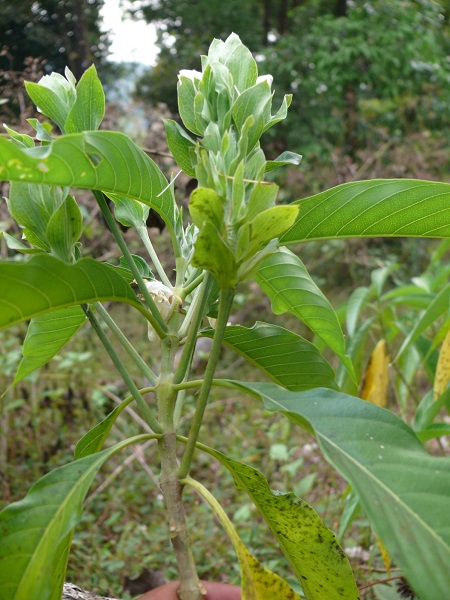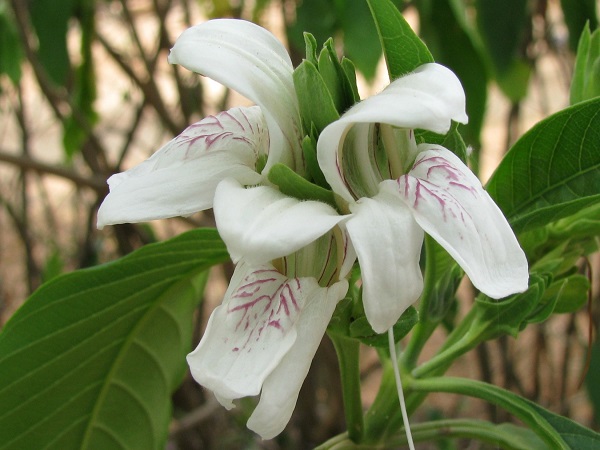
| Family | Acanthaceae |
| English Name | Adathoda |
| Malayalam Name | Aatalootakam |
| Tamil Name | Adathodai |
| Kannada Name | Adusoge |
| Telugu Name | Addasaram |
| Hindi Name | Arus, Arusa, Aramadya, Aus, Ainh-parni, Aajini, Aisauta |
| Sanskrit Name | Arus, Vajidantakahaatarusha, Vasa, Vasaka |
| Trade Name | Vasika |
| Part Used | Whole plant |
| In Wild | No |
| Under Cultivation | Yes |
| Temperature | 20 - 27°C |
| Rainfall | 700 - 1,700mm |
| Farmers | 1. Mr. Mr. NANDAKUMAR B #112/19 Avaithuru nagar, 7th streetChinmayanagar Chennai 600092 Ph: 8124344412, email: nandhub2905@gmail.com 2. Mr. KRISHNAMURTHY K Malyanur, Veppur, Cuddalone , Tamilnadu Ph: 9150090060, email: jamunaattar@gmail.com 3. Mr. SIDDALINGESHWARA Mallarajapattana, ramanathapura, Arakalagudu, Hassan 573133 Ph: 9449660225. 4. Mr. PADMA NASHA, Mallarajapattana, ramanathapura, Arakalagudu, Hassan 573133 Ph: 9972008186 |
| Traders | 1. Mr. NANDAKUMAR B #112/19 Avaithuru nagar, 7th streetChinmayanagar Chennai 600092 Ph: 8124344412, email: nandhub2905@gmail.com |
| Institution | NA |
| Individually | NA |
| State/Region | NA |
| District | NA |
| Nursery Information | NA |
| Yield | Total yield of root, stem and leaves from one hectare of area will be 10-11 tons. |
| Economic of cultivation | Market price: Rs 45 - 55/kg (as on 2018) |
| Quantitative quality standards | a. Foreign matter (other plant parts, soil, stone, sand, dust, organisms and their parts) : Not more than 2.0 percent (W/W). b. Ash : Not more than 14.29 percent (W/W). c. Acid-insoluble ash : Not more than 0.75 percent (W/V). d. Ethanol-soluble extractives : Not less than 6.12 percent (W/V). e. Water-soluble extractive : Not less than 23.39 percent (W/V). |
| Description | Evergreen, much-branched perennial shrubs with a strong odour, 1.2-3 m tall. Leaves simple,opposite, 5-30 cm long, elliptic-lanceolate or ovate-lanceolate, apex acute, margins entire, hairy,light green above, dark beneath, leathery; petiole 1-2.5 cm long. Flowers in compact, axillary,pedunculate spikes; peduncles 3-10 cm long; bracts 2 x 1 cm, elliptic, subacute, 6-7 nerved;bracteoles 2 x 0.4 cm, oblong-lanceolate, 1-nerved. Calyx lobes 1 cm long, oblong-lanceolate,3-nerved. Corolla white with red or yellow-barred throats; upper lip 2 x 1 cm, curved, obtuse,notched; lower as long as the upper lip. Stamens 2, anther cells not tailed; filaments hairy at the base. Ovary pubescent; ovules 2 in each cell; style hairy towards the base. Fruits clavate,longitudinally channelled, 1.9-2.2 x 0.8 cm wide, pubescent; seeds 4, globular, glabrous. |
| Agro technology/Cultivation practices | Agro-ecological requirements Vasika can grow in a variety of climatic and soil conditions. Alluvial soils are suited for best growth. It can also be cultivated as an inter crop in coconut plantations and rubber plantations in the initial 3-4 years. Planting-stock production Vegetative propagation : Vasika is propagated using terminal/lateral stem tender cuttings of 15-20 cm long and 3-4 nodes. Pre rooted cuttings give better results in the field. Nursery preparation can be done in March-April. For this, the tender stem cuttings are planted in poly bags filled with potting mixture prepared using farm yard manure/vermicompost, top soil and sand. Cuttings will root readily and will be ready to transplant to field after two months. Cultivation Field planting : Rooted cuttings of Adhatoda can be planted on mounds or ridges. Plough and level the main field thoroughly and ridges or mounds are prepared 60 cm away from each other. With the commencement of rainfall, rooted cuttings are planted on the ridges with a plant to plant spacing of 30 cm. If grown on mounds, up to 5 cuttings. May be planted on a single 7 mound. In sloppy areas cuttings are planted directly by making holes with a sharp pole. Adequate care should be taken to prevent water logging as it may promote rotting. Manuring/Fertilization : Apply organic manure in the form of FYM, compost or green leaf at the rate of 10 t/ha as basal dressing. Keep the field free of weeds and give earthling up after topdressing with fertilizers. Irrigation : Irrigation is not essential during monsoon. Irrigate the crops at an interval of 4 days in drought conditions. Pest and diseases: Not serious. |
| Harversting | Leaves, roots and stem of Vasika are of medicinal value. Leaves can be harvested one year after planting at an interval 3-4 months, but roots will be ready to harvest only two years after planting. December-January is the ideal time for harvesting roots. In the second year, the entire plant is harvested and roots are carefully dug out. |
| Processing | Harvested roots are washed,cleaned and marketed either in fresh form or after drying. |
| References | CSIR. 1985. Wealth of India - Raw Materials & Industrial Products: Vol.IA (revised edition). Council of Scientific and Industrial Research, New Delhi, pp. 76 - 79. ICMR. 2003. Quality standards of Indian medicinal plants, Vol. 3. Medicinal Plants Unit, Indian Council of Medicinal Research, New Delhi, pp 1 - 8. NMPB.2002 Cultivation practices of some commercially important medicinal plants. National Medicinal Plants Board, Government of India, New Delhi. Envis center on medicinal plants.http://envis.frlht.org/bot_search (Dt.22.05.2018) Aromatic and Medicinal Plants Research Station.https://www.amprsagrotech.nic.in/index.php?option=com_content&view=article&id=927&Itemid=194 (Dt. 22.05.2018) |

